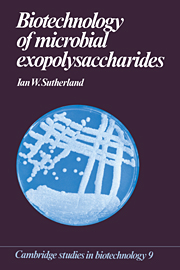Book contents
- Frontmatter
- Contents
- Preface
- 1 Introduction and definition
- 2 Polysaccharide analysis and structural determination
- 3 Exopolysaccharide structure
- 4 Enzymes degrading exopolysaccharides
- 5 Biosynthesis
- 6 Physiology and industrial production
- 7 Genetics, control and regulation of exopolysaccharide synthesis
- 8 Physical properties of exopolysaccharides
- 9 Food usage of exopolysaccharides
- 10 Industrial uses of microbial polysaccharides
- 11 Medical applications of exopolysaccharides
- 12 The future for microbial exopolysaccharides
- References
- Index
2 - Polysaccharide analysis and structural determination
Published online by Cambridge University Press: 09 September 2009
- Frontmatter
- Contents
- Preface
- 1 Introduction and definition
- 2 Polysaccharide analysis and structural determination
- 3 Exopolysaccharide structure
- 4 Enzymes degrading exopolysaccharides
- 5 Biosynthesis
- 6 Physiology and industrial production
- 7 Genetics, control and regulation of exopolysaccharide synthesis
- 8 Physical properties of exopolysaccharides
- 9 Food usage of exopolysaccharides
- 10 Industrial uses of microbial polysaccharides
- 11 Medical applications of exopolysaccharides
- 12 The future for microbial exopolysaccharides
- References
- Index
Summary
Introduction
The information that needs to be obtained in respect of defining microbial exopolysaccharides can be summarised under the headings of polymer composition and of structural analysis. Composition covers not only the monosaccharide components but also the various possible acyl groups and inorganic substituents. Structural analysis involves various approaches. These range from partial fragmentation by acid or enzymic hydrolysis to produce oligosaccharides, the structures of which must then themselves be determined, to methylation and sequence analysis.
Analysis of polysaccharide composition
Exopolysaccharides are composed of three distinct types of monomer. They are of course predominantly carbohydrate in nature but, in addition to the various sugars, there may be organic and inorganic substituents. The individual sugars can seldom be analysed in the intact polymer although it is often possible to use colorimetric assays to quantitate specific types of sugars such as pentoses, 6-deoxyhexoses, heptoses, uronic acids and amino sugars. If the specific monosaccharides are to be determined quantitatively, they must first be released by hydrolysis.
Determination of the composition of microbial exopolysaccharides is essentially similar to that of any other comparable polymer. The polymer is hydrolysed with acid to yield the component monosaccharides, which are then identified and quantified. During hydrolysis, labile groups such as ester-linked components and ketals are likely to be removed and must be separately recovered and identified. A careful choice of hydrolysis conditions must also be made. Monosaccharides differ in their stability to acid at high temperatures; the glycosidic bonds vary considerably in their resistance to hydrolysis.
- Type
- Chapter
- Information
- Biotechnology of Microbial Exopolysaccharides , pp. 12 - 19Publisher: Cambridge University PressPrint publication year: 1990
- 4
- Cited by



